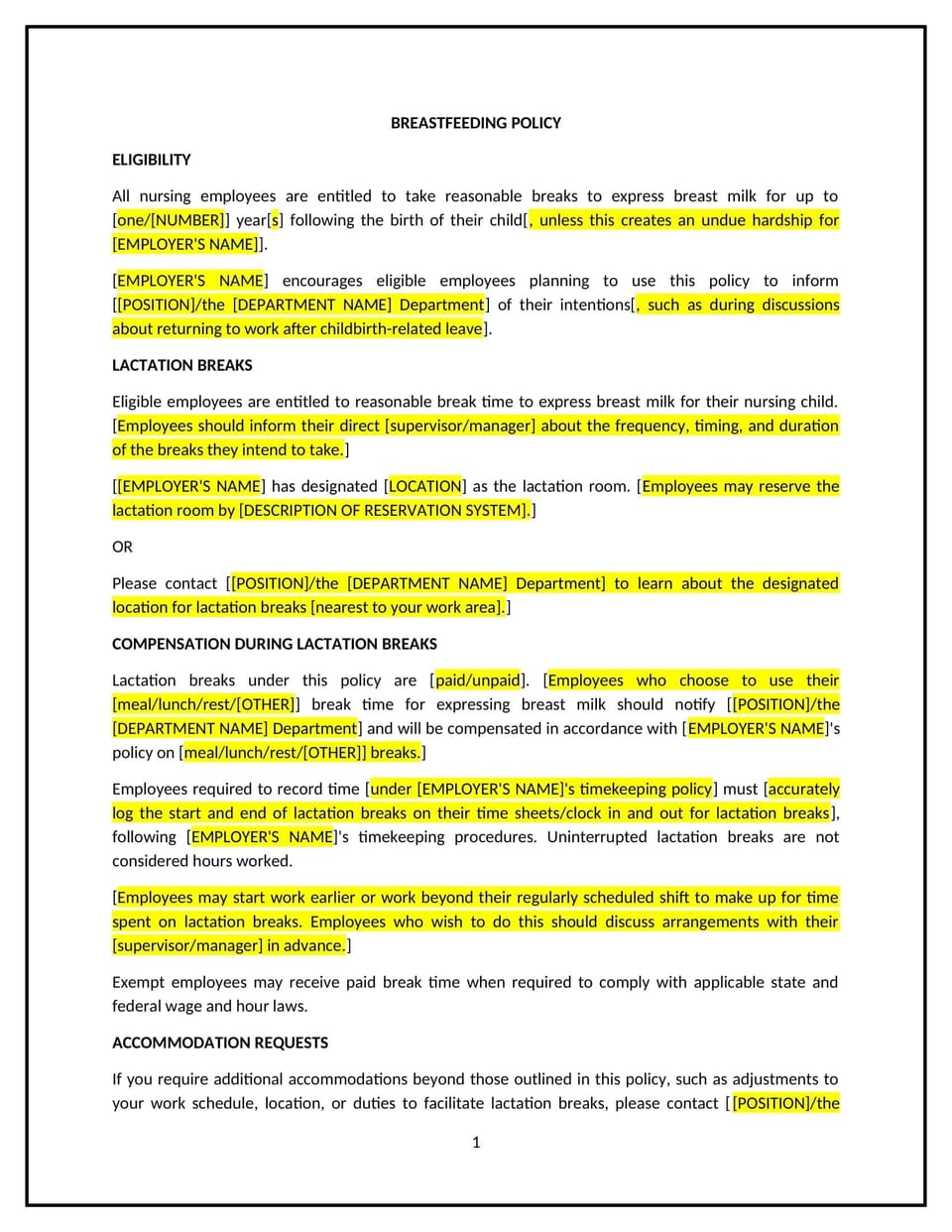Breastfeeding break policy (Minnesota): Free template

Breastfeeding break policy (Minnesota)
This breastfeeding break policy is designed to help Minnesota businesses create a supportive environment for breastfeeding employees by providing appropriate break times and spaces for nursing or pumping. It outlines the procedures for requesting and taking breastfeeding breaks, as well as the responsibilities of both employees and employers.
By implementing this policy, businesses can support employee health, foster a positive workplace culture, and comply with local regulations regarding lactation rights.
How to use this breastfeeding break policy (Minnesota)
- Define break periods: Specify the amount of time allotted for breastfeeding or pumping breaks, and how frequently breaks can be taken throughout the workday.
- Outline designated areas: Identify appropriate, private, and hygienic locations where employees can breastfeed or pump during breaks.
- Provide flexibility: Allow employees to take breaks at times that fit their work schedule, especially in roles where flexibility is necessary.
- Address pay: Clarify whether these breaks are paid or unpaid, and the company’s stance on compensation for time spent on lactation breaks.
- Communicate responsibilities: Clearly outline the expectations for both employees and supervisors regarding the timing and duration of breaks.
- Include storage procedures: Specify how employees can store breast milk safely during their workday.
Benefits of using a breastfeeding break policy (Minnesota)
Implementing this policy provides several advantages for Minnesota businesses:
- Supports employee well-being: Promotes health and productivity by allowing breastfeeding employees to continue to care for their child while maintaining their job.
- Enhances retention: Provides a family-friendly workplace that can help retain talented employees.
- Demonstrates inclusivity: Shows the company’s commitment to supporting diverse employee needs, promoting a positive and respectful work environment.
- Reflects Minnesota-specific considerations: Tailors to local business practices, healthcare standards, and community values.
Tips for using this breastfeeding break policy (Minnesota)
- Communicate clearly: Ensure employees are aware of their rights to breastfeeding breaks and know how to request them.
- Provide appropriate facilities: Designate clean, private, and comfortable spaces for employees to breastfeed or pump.
- Be flexible: Work with employees to accommodate their needs for flexibility, especially in high-demand or client-facing roles.
- Respect privacy: Maintain confidentiality regarding employees’ breastfeeding activities and any personal details.
- Update regularly: Review the policy annually to ensure it aligns with any changes in state laws, workplace practices, or employee needs.
Q: How long can employees take for breastfeeding or pumping breaks?
A: Businesses should provide reasonable break time, with the length of breaks dependent on the needs of the employee, but at least 20 minutes should be allotted for each session to accommodate both nursing and storage needs.
Q: Should businesses provide private spaces for breastfeeding or pumping?
A: Yes, businesses should provide private, clean, and secure spaces for employees to breastfeed or pump, separate from restrooms, to protect employees' health and dignity.
Q: Are employees entitled to paid breastfeeding breaks?
A: In Minnesota, breastfeeding breaks are generally unpaid unless the employee is working during that time. However, businesses can choose to offer paid breaks for this purpose as part of their company benefits.
Q: How should businesses handle multiple employees needing breastfeeding breaks at the same time?
A: Businesses should make reasonable accommodations for employees needing breastfeeding breaks at the same time, such as staggered break schedules or expanding the available private spaces.
Q: Can breastfeeding breaks be taken in addition to regular rest or lunch breaks?
A: Yes, businesses should allow employees to take breastfeeding breaks in addition to regular rest or lunch breaks to accommodate their nursing or pumping needs.
Q: What steps should businesses take if an employee needs additional time for breastfeeding breaks?
A: Businesses should assess each employee’s specific situation and make reasonable accommodations. If an employee requires more time than is typically allocated, they should work with their manager or HR to find a suitable solution.
Q: How often should this policy be reviewed?
A: The policy should be reviewed annually or whenever there are changes to state or federal laws, company operations, or employee needs.
This article contains general legal information and does not contain legal advice. Cobrief is not a law firm or a substitute for an attorney or law firm. The law is complex and changes often. For legal advice, please ask a lawyer.


